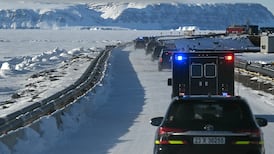"Does the fear justify the security or the security justify the fear?" was how a defence lawyer for one of the men accused of the 9/11 attacks on New York put it on my recent trip to Guantánamo Bay.
Over a burger and chips in the US naval base's Irish pub, the lawyer was discussing the aggressive security measures taken by law enforcement agencies since 2001 to prevent further attacks and whether they have gone too far in encroaching on the rights and privacy of US citizens. From a lawyer representing a man locked up for more than a decade in maximum security in a US prison in Cuba, it was hardly a surprising question. However, it raises an important point about US society.
Striking a balance between protecting civil liberties and safeguarding Fortress America has grown more contentious over the past 12 years in the US and particularly in more recent times since disclosures about surveillance programmes to spy on the phone calls, emails and internet activity of everyday Americans have emerged from leaks by former National Security Agency contractor Edward Snowden.
A new book, Enemies Within, traces another area of surveillance: the activities of the New York Police Department's intelligence division and its spying on the city's Muslim community. The book reveals how the police legally skirted around First Amendment restrictions protecting citizens' freedom to worship to spy on Islamic groups where they suspect, often on highly tenuous grounds, terrorist cells may be operating.
Written by Washington-based Associated Press reporters Matt Apuzzo and Adam Goldman, members of the Pulitzer Prize-winning team that revealed details about the depth of the NYPD's spying programme, the book shows how the police categorised entire mosques as potential terrorist organisations to justify "terrorism enterprise investigations" under court-approved guidelines.
'A miniature CIA'
Stung by the failures of the US law enforcement community to respond to the warnings signs in the run-up to 9/11, the NYPD was not prepared to leave surveillance to the CIA or FBI alone and decided to create its own intelligence team with a $60 million budget that operated in "near secrecy and fancied itself as a miniature CIA," the authors write.
The extent of the spying was far-reaching and trampled over the civil rights of average citizens, all because they were Muslim. The police recruited informants, often on minor misdemeanours, to work as “mosque crawlers” visiting centres of prayer to spy on sermons. They took note of phone numbers, email addresses and car registration plates, and listened out for any radicalised or jihadist views.
David Cohen, head of the NYPD's intelligence division and a former CIA official, characterised the spying as racking a fire pit: "You might find a smouldering ember – a hotspot waiting to catch fire."
The surveillance went beyond mosques. “Rakers” sipped tea in cafes and spoke to workers at deli counters and dollar stores owned by Pakistanis and Egyptians, at Afghan fried chicken joints and corner stores owned by black Muslims listening for anything that might spark a deeper investigation exposing a terrorist plot. They created a law enforcement guide for New York’s Muslims.
A Sudanese owner of a shop in Brooklyn that sold Islamic books alongside incense and bath products was put on a watch list because of vague assertions that he was anti-American, despite having no criminal record. One Islamic teacher at mosques across New York was considered a threat because he was a puritanical Muslim and popular among “young and impressionable individuals”, the book says.
Latitude
The legal basis sanctioning the surveillance gave remarkable latitude to the NYPD. A judge's ruling in April 2003 paving the way for these activities found that, even when there is no suspected offence, an investigation "often requires the fitting together of bits and pieces of information, many meaningless by themselves, to determine whether a pattern of unlawful activity exists".
This was new ground as previously federal investigations ruled places of worship as off-limits. The authors point out, that even when IRA members occasionally gathered in St Patrick’s Cathedral in New York, the FBI hadn’t followed but picked up the trail after suspects had left the places of worship.
In a short period the NYPD, a force twice the size of the FBI, had become involved in the business of secretly analysing the religious and political views of US citizens and saw activities protected by the First Amendment constitutional right as precursors to terrorism, Apuzzo and Goldman write.
The authors weave details of the spying programme with the race to stop an al-Qaeda- trained bomber Najibullah Zazi as he travels from his home in Colorado to New York in a plan to bomb the New York City subway system, described on the cover of the book as "Bin Laden's final plot against America".
This, at times, turns this brilliantly researched account of post-9/11 excesses of US law enforcement into a page-turning thriller, while exploring the US’s difficult relationship with fear and security.
















